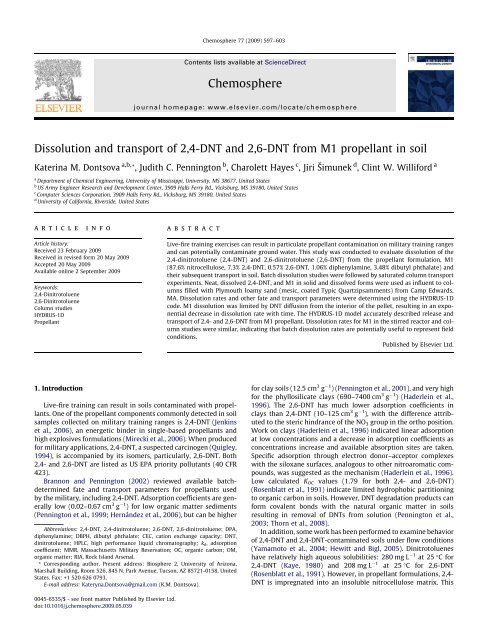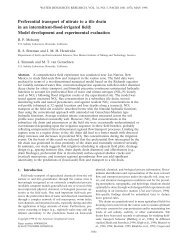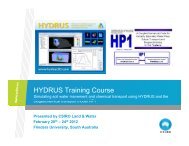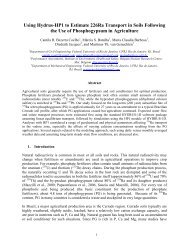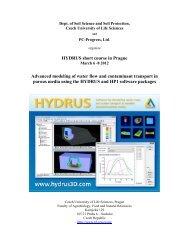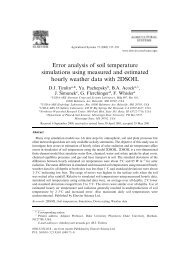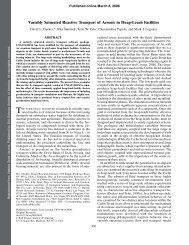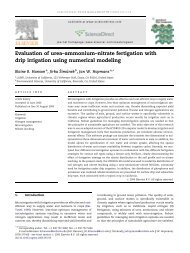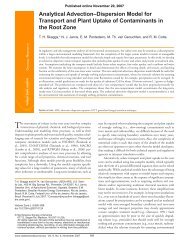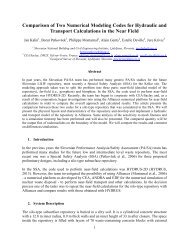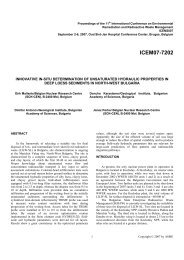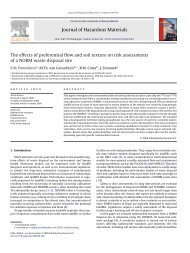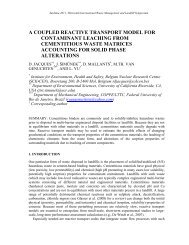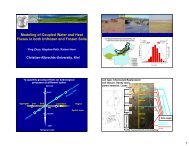Dissolution and transport of 2,4-DNT and 2,6-DNT ... - ResearchGate
Dissolution and transport of 2,4-DNT and 2,6-DNT ... - ResearchGate
Dissolution and transport of 2,4-DNT and 2,6-DNT ... - ResearchGate
Create successful ePaper yourself
Turn your PDF publications into a flip-book with our unique Google optimized e-Paper software.
Chemosphere 77 (2009) 597–603Contents lists available at ScienceDirectChemospherejournal homepage: www.elsevier.com/locate/chemosphere<strong>Dissolution</strong> <strong>and</strong> <strong>transport</strong> <strong>of</strong> 2,4-<strong>DNT</strong> <strong>and</strong> 2,6-<strong>DNT</strong> from M1 propellant in soilKaterina M. Dontsova a,b, *, Judith C. Pennington b , Charolett Hayes c , Jiri Šimunek d , Clint W. Williford aa Department <strong>of</strong> Chemical Engineering, University <strong>of</strong> Mississippi, University, MS 38677, United Statesb US Army Engineer Research <strong>and</strong> Development Center, 3909 Halls Ferry Rd., Vicksburg, MS 39180, United Statesc Computer Sciences Corporation, 3909 Halls Ferry Rd., Vicksburg, MS 39180, United Statesd University <strong>of</strong> California, Riverside, United StatesarticleinfoabstractArticle history:Received 23 February 2009Received in revised form 20 May 2009Accepted 20 May 2009Available online 2 September 2009Keywords:2,4-Dinitrotoluene2,6-DinitrotolueneColumn studiesHYDRUS-1DPropellantLive-fire training exercises can result in particulate propellant contamination on military training ranges<strong>and</strong> can potentially contaminate ground water. This study was conducted to evaluate dissolution <strong>of</strong> the2,4-dinitrotoluene (2,4-<strong>DNT</strong>) <strong>and</strong> 2,6-dinitrotoluene (2,6-<strong>DNT</strong>) from the propellant formulation, M1(87.6% nitrocellulose, 7.3% 2,4-<strong>DNT</strong>, 0.57% 2,6-<strong>DNT</strong>, 1.06% diphenylamine, 3.48% dibutyl phthalate) <strong>and</strong>their subsequent <strong>transport</strong> in soil. Batch dissolution studies were followed by saturated column <strong>transport</strong>experiments. Neat, dissolved 2,4-<strong>DNT</strong>, <strong>and</strong> M1 in solid <strong>and</strong> dissolved forms were used as influent to columnsfilled with Plymouth loamy s<strong>and</strong> (mesic, coated Typic Quartzipsamments) from Camp Edwards,MA. <strong>Dissolution</strong> rates <strong>and</strong> other fate <strong>and</strong> <strong>transport</strong> parameters were determined using the HYDRUS-1Dcode. M1 dissolution was limited by <strong>DNT</strong> diffusion from the interior <strong>of</strong> the pellet, resulting in an exponentialdecrease in dissolution rate with time. The HYDRUS-1D model accurately described release <strong>and</strong><strong>transport</strong> <strong>of</strong> 2,4- <strong>and</strong> 2,6-<strong>DNT</strong> from M1 propellant. <strong>Dissolution</strong> rates for M1 in the stirred reactor <strong>and</strong> columnstudies were similar, indicating that batch dissolution rates are potentially useful to represent fieldconditions.Published by Elsevier Ltd.1. IntroductionLive-fire training can result in soils contaminated with propellants.One <strong>of</strong> the propellant components commonly detected in soilsamples collected on military training ranges is 2,4-<strong>DNT</strong> (Jenkinset al., 2006), an energetic binder in single-based propellants <strong>and</strong>high explosives formulations (Mirecki et al., 2006). When producedfor military applications, 2,4-<strong>DNT</strong>, a suspected carcinogen (Quigley,1994), is accompanied by its isomers, particularly, 2,6-<strong>DNT</strong>. Both2,4- <strong>and</strong> 2,6-<strong>DNT</strong> are listed as US EPA priority pollutants (40 CFR423).Brannon <strong>and</strong> Pennington (2002) reviewed available batchdeterminedfate <strong>and</strong> <strong>transport</strong> parameters for propellants usedby the military, including 2,4-<strong>DNT</strong>. Adsorption coefficients are generallylow (0.02–0.67 cm 3 g 1 ) for low organic matter sediments(Pennington et al., 1999; Hernández et al., 2006), but can be higherAbbreviations: 2,4-<strong>DNT</strong>, 2,4-dinitrotoluene; 2,6-<strong>DNT</strong>, 2,6-dinitrotoluene; DPA,diphenylamine; DBPH, dibutyl phthalate; CEC, cation exchange capacity; <strong>DNT</strong>,dinitrotoluene; HPLC, high performance liquid chromatography; k d , adsorptioncoefficient; MMR, Massachusetts Military Reservation; OC, organic carbon; OM,organic matter; RIA, Rock Isl<strong>and</strong> Arsenal.* Corresponding author. Present address: Biosphere 2, University <strong>of</strong> Arizona,Marshall Building, Room 526, 845 N. Park Avenue, Tucson, AZ 85721-0158, UnitedStates. Fax: +1 520 626 0793.E-mail address: Kateryna.Dontsova@gmail.com (K.M. Dontsova).for clay soils (12.5 cm 3 g 1 )(Pennington et al., 2001), <strong>and</strong> very highfor the phyllosilicate clays (690–7400 cm 3 g 1 )(Haderlein et al.,1996). The 2,6-<strong>DNT</strong> has much lower adsorption coefficients inclays than 2,4-<strong>DNT</strong> (10–125 cm 3 g 1 ), with the difference attributedto the steric hindrance <strong>of</strong> the NO 3 group in the ortho position.Work on clays (Haderlein et al., 1996) indicated linear adsorptionat low concentrations <strong>and</strong> a decrease in adsorption coefficients asconcentrations increase <strong>and</strong> available absorption sites are taken.Specific adsorption through electron donor–acceptor complexeswith the siloxane surfaces, analogous to other nitroaromatic compounds,was suggested as the mechanism (Haderlein et al., 1996).Low calculated K OC values (1.79 for both 2,4- <strong>and</strong> 2,6-<strong>DNT</strong>)(Rosenblatt et al., 1991) indicate limited hydrophobic partitioningto organic carbon in soils. However, <strong>DNT</strong> degradation products canform covalent bonds with the natural organic matter in soilsresulting in removal <strong>of</strong> <strong>DNT</strong>s from solution (Pennington et al.,2003; Thorn et al., 2008).In addition, some work has been performed to examine behavior<strong>of</strong> 2,4-<strong>DNT</strong> <strong>and</strong> 2,4-<strong>DNT</strong>-contaminated soils under flow conditions(Yamamoto et al., 2004; Hewitt <strong>and</strong> Bigl, 2005). Dinitrotolueneshave relatively high aqueous solubilities: 280 mg L 1 at 25 °C for2,4-<strong>DNT</strong> (Kaye, 1980) <strong>and</strong> 208 mg L 1 at 25 °C for 2,6-<strong>DNT</strong>(Rosenblatt et al., 1991). However, in propellant formulations, 2,4-<strong>DNT</strong> is impregnated into an insoluble nitrocellulose matrix. This0045-6535/$ - see front matter Published by Elsevier Ltd.doi:10.1016/j.chemosphere.2009.05.039
598 K.M. Dontsova et al. / Chemosphere 77 (2009) 597–603process will likely affect release <strong>of</strong> propellants into solution. Forexplosives, binders <strong>and</strong> waxes present in formulations have beenshown to decrease dissolution rates <strong>of</strong> individual explosive compounds(Lynch et al., 2002; Phelan et al., 2002). A similar trendwas observed for dissolution <strong>of</strong> several propellant formulations inbatch studies (Mirecki et al., 2006). In columns, Hewitt <strong>and</strong> Bigl(2005) measured no 2,4-<strong>DNT</strong> release from a soil containing particulateM1 propellant residues. The effects <strong>of</strong> formulation on other fate<strong>and</strong> <strong>transport</strong> processes are unknown.This study focused on M1, one <strong>of</strong> the single-base, 2,4-<strong>DNT</strong> containingpropellants used by the military. In addition to insolublenitrocellulose <strong>and</strong> <strong>DNT</strong>s, M1 contains diphenylamine (DPA) <strong>and</strong>dibutyl phthalate (DBPH). Diphenylamine is used as a stabilizer,while DBPH is a plasticizer. These compounds were not evaluatedin this study.The objective <strong>of</strong> this study was to determine release rates <strong>and</strong><strong>transport</strong> parameters for 2,4- <strong>and</strong> 2,6-<strong>DNT</strong> from solid phase M1propellant under saturated flow conditions. The parameters forsolid M1 propellant were compared with those for neat 2,4-<strong>DNT</strong>;2,4- <strong>and</strong> 2,6-<strong>DNT</strong> in dissolved M1; <strong>and</strong> with adsorption coefficientsreported in the literature.2. Materials <strong>and</strong> methods2.1. SoilsPlymouth loamy s<strong>and</strong> (mesic, coated Typic Quartzipsamments)was used for this experiment. Samples were collected at CampEdwards, MA (Massachusetts Military Reservation [MMR]) to adepth <strong>of</strong> 20 cm. Soil was air-dried, ground, passed through a2-mm sieve, <strong>and</strong> analyzed for cation exchange capacity (CEC) usingthe NaAc method (US Environmental Protection Agency, 1986) <strong>and</strong>organic matter using the Walkley-Black method. Particle size wasdetermined by the hydrometer method (Gee <strong>and</strong> Or, 2002). Thesoil pH in 1:1 soil/water slurry, exchangeable cations, <strong>and</strong> base saturationwere also measured. The soil had relatively low organicmatter (8.5 g kg 1 ) <strong>and</strong> CEC (4.4 cmolc kg 1 ), base saturation <strong>of</strong>9.7%, <strong>and</strong> pH <strong>of</strong> 5.2. Collected samples contained 93.3% s<strong>and</strong>,5.8% silt, <strong>and</strong> 0.8% clay.2.2. PropellantsM1 propellants are produced as dark green, single- or multiperforatedcylinders. Single-perforated cylinders are smaller withone perforation in the middle, while multi-perforated are larger<strong>and</strong> have seven perforations per cylinder. According to specifications,all M1 formulations contain 85 ± 2% nitrocellulose, 10 ± 2%<strong>DNT</strong>, 5 ± 1% DBPH, <strong>and</strong> 1.0 ± 0.10 DPA. They can also contain PbCO 3(1.0 ± 0.3%), K 2 SO 4 (1.0 ± 0.3%) <strong>and</strong> retain some residual solvent(max 0.9%) <strong>and</strong> moisture (0.6 ± 0.2%) (Defense Ammunition Center,2003). Propellant compositions used in this study contained K 2 SO 4as a flash reducer.Two different M1 formulations were obtained from Rock Isl<strong>and</strong>Arsenal (RIA): multi-perforated M1 propellant (8 mm in length <strong>and</strong>3 mm in diameter) <strong>and</strong> single perforated M1 propellant (5 mm inlength <strong>and</strong> 1 mm in diameter). Propellants were manufacturedby Radford Army Ammunition Plant, Radford, VA, in 2005 <strong>and</strong>2006, respectively.Both formulations <strong>of</strong> M1 propellant were analyzed for totalcomposition. Propellant cylinders were extracted in acetonitrile.Extracts were analyzed for 2,4- <strong>and</strong> 2,6-<strong>DNT</strong> by High PerformanceLiquid Chromatography (HPLC) (Waters HPLC, GenTech Scientific,Inc., Arcade, NY), Method 8330 (US Environmental ProtectionAgency, 1994) <strong>and</strong> for DPA <strong>and</strong> DBPH by GC/MS, Method 8270C(US Environmental Protection Agency, 1996).2.3. <strong>Dissolution</strong> in stirred reactorsIn stirred reactor batch dissolution studies, 10 g samples <strong>of</strong> propellantwere added to 3.5 L <strong>of</strong> de-ionized water <strong>and</strong> stirred for6 days. The solution was sampled before adding the propellant<strong>and</strong> at 2, 6, 12, 24, 48, 72, 96, 120, <strong>and</strong> 144 h <strong>of</strong> stirring. After6 days, the 144 h samples were analyzed for 2,4-<strong>DNT</strong> by HPLCMethod 8330 (US Environmental Protection Agency, 1994). Stirring<strong>of</strong> the small single-perforated propellant resulted in higherconcentrations (4.69 ± 0.13 mg L 1 , average <strong>of</strong> two replications)than stirring <strong>of</strong> the larger multi-perforated formulation (3.01 ±0.03 mg L 1 ). Consequently, dissolution kinetics were determinedfor the single-perforated formulation by analysis for 2,4-<strong>DNT</strong>,<strong>and</strong> 2,6-<strong>DNT</strong> in samples collected over time. Samples collected at144 h were also analyzed for DPA <strong>and</strong> DBPH. Solutions obtainedfrom the single-perforated M1 propellant tests were used in columnexperiments.2.4. Saturated flow experimentsMethods for saturated flow column experiments are describedin detail in Dontsova et al. (2006). Briefly, flux-controlled stainlesssteel flow-through columns (10.16-cm internal diameter by 17.00-cm height) were supplied with solution by a Fisherbr<strong>and</strong> Ultralow-Flow Peristaltic Pump (Fisher Scientific Houston, TX). Outflowsamples were collected continuously into 40-mL vials using anautomated Universal fraction collector with 50-vial capacity (EldexLaboratories, Inc. Napa, California). Soils were packed into columnsto an average bulk density <strong>of</strong> 1.67 ± 0.09 g cm 3 .Columns were saturated from the bottom using 0.005 M CaBr 2background solution. Pore volume (0.462 ± 0.046 L) <strong>and</strong> volumetricwater content (h), were determined during saturation from the volume<strong>of</strong> solution necessary to fill the packed column. Columns werethen connected to the pump <strong>and</strong> operated in downflow mode. Theaverage flow rate was 1.12 ± 0.17 mL min 1 , or solution flux <strong>of</strong>0.83 ± 0.13 cm h 1 . In 2,4-<strong>DNT</strong> or dissolved M1 experiments, studiedsolutes in 0.005 M CaBr 2 background were applied to the column.In solid M1 experiments, M1 cylinders were placed on thesoil surface between two layers <strong>of</strong> glass wool <strong>and</strong> a 0.005 M CaBr 2background solution was applied.Target concentration <strong>of</strong> analytical grade 2,4-<strong>DNT</strong> for the neat2,4-<strong>DNT</strong> experiments was 10 mg L 1 ; measured concentrationwas 9.91 ± 0.68 mg L 1 . In experiments with dissolved M1 propellant,the input concentration <strong>of</strong> 2,4-<strong>DNT</strong> was 4.87 ± 0.15 mg L 1 ,while the 2,6-<strong>DNT</strong> concentration was 0.194 ± 0.005 mg L 1 . M1solutions also contained 358 ± 23 lgL 1 <strong>of</strong> DPA <strong>and</strong> 33 ± 13 lgL 1<strong>of</strong> DBPH.Uniformly ring-labeled 14 C-2,4-<strong>DNT</strong> was added as a tracer tothe bulk solutions (specific activity 16.67 mCi mmol 1 ) at 0.037%<strong>of</strong> total 2,4-<strong>DNT</strong> in solution. The radiotracer allowed monitoring<strong>of</strong> 2,4-<strong>DNT</strong> concentrations in outflow as the experiment progressed.Comparison <strong>of</strong> breakthrough curves <strong>of</strong> labeled <strong>and</strong> unlabeled2,4-<strong>DNT</strong> allowed us to distinguish between transformation<strong>and</strong> mineralization <strong>of</strong> 2,4-<strong>DNT</strong>. Tritiated water ( 3 H 2 O) (specificactivity <strong>of</strong> 2.18 mCi mmol 1 with 1.239 10 6 %<strong>of</strong> 3 H 2 O in solution)was applied with the solutes to determine the longitudinaldispersivity (k) for each soil <strong>and</strong> monitor for signs <strong>of</strong> preferentialflow.After six pore volumes <strong>of</strong> propellant solution the flow wasswitched back to the background solution (or the solid M1 was removed),which was applied for another 14–18 pore volumes. Flowinterruption was used to observe kinetic processes (Murali <strong>and</strong>Aylmore, 1980; Šimunek et al., 2002). For every soil/propellanttreatment two experiments were conducted. In one, flow wascontinuous, while in the other, both inflow <strong>and</strong> outflow from the
K.M. Dontsova et al. / Chemosphere 77 (2009) 597–603 599Table 1Total content <strong>of</strong> 2,6-<strong>DNT</strong>, 2,4-<strong>DNT</strong>, DBPH, <strong>and</strong> DPA in several M1 propellantformulations.column were stopped for 24 h to allow propellant constituents toequilibrate with the soil.Every second outflow sample (approximately every 0.075 L)was analyzed by scintillation counting (Tri-Carb 2500TX LiquidScintillation Analyzer, PerkinElmer Life <strong>and</strong> Analytical Sciences,Inc., Boston, MA). Based on 14 C tracer results about 16–18 samplesper breakthrough curve were selected for HPLC analysis using st<strong>and</strong>ardEPA Method 8330 (US Environmental Protection Agency,1994). Detection limit was 20 lgL 1 for both 2,4-<strong>DNT</strong> <strong>and</strong> 2,6-<strong>DNT</strong>.2.5. Numerical analysis2,6-<strong>DNT</strong> (%) 2,4-<strong>DNT</strong> (%) DBPH (%) DPA (%)RIA a multi-perforated 0.48 ± 0.002 8.61 ± 0.045 3.40 ± 0.16 1.25 ± 0.28RIA single-perforated 0.57 ± 0.028 7.34 ± 0.43 3.48 ± 0.28 1.06 ± 0.06aRIA Rock Isl<strong>and</strong> Arsenal.Experiments were analyzed using the HYDRUS-1D code for simulatingthe one-dimensional movement <strong>of</strong> water, heat <strong>and</strong> multiplesolutes in variably saturated porous media (Šimunek et al.,2005). The following models were used in analysis: convection–dispersion equation for 3 H 2 O tracer <strong>and</strong> the two-site sorption model(with decay) (chemical non-equilibrium model) for propellantsusing approach similar to one applied to dissolution <strong>of</strong> explosives(Dontsova et al., 2006). The 3 H 2 O breakthrough curves were usedto estimate the longitudinal dispersivity, k (cm). Then, k was fixedat a value determined for tracer <strong>and</strong> the following parameters wereestimated for propellants: a fraction <strong>of</strong> sites with instantaneousadsorption, f, adsorption coefficient, k d (cm 3 g 1 ), a first-order ratecoefficient for dissolved phase (degradation rate), l w (h 1 ), <strong>and</strong> afirst-order rate coefficient for two-site non-equilibrium adsorption,x (h 1 ). In 14 C radiotracer experiments the rate coefficient (l w )corresponded to irreversible attenuation <strong>and</strong> mineralization, whilein HPLC experiments it corresponded to the sum <strong>of</strong> attenuation,mineralization, <strong>and</strong> transformation.For experiments with solid M1 propellant formulation, 2,4-<strong>DNT</strong><strong>and</strong> 2,6-<strong>DNT</strong> dissolution rate, c (lgg 1 h 1 ) was defined asfollows:c ¼ ne vtð1Þwhere n is the initial dissolution rate (lgg 1 h 1 ), v is decay constant(h 1 ) <strong>and</strong> t is time (T).Table 3Fraction <strong>of</strong> solutes recovered in outflow in the column <strong>transport</strong> experimentsinvolving 3 H 2 O, 14 C-2,4-<strong>DNT</strong>, 2,4-<strong>DNT</strong>, dissolved <strong>and</strong> solid M1 propellant in Plymouthsoil.Treatment3 H 2 OEach breakthrough curve was integrated to calculate recovery<strong>of</strong> the 14 C-2,4-<strong>DNT</strong> <strong>and</strong> HPLC-measured 2,4-<strong>DNT</strong> <strong>and</strong> 2,6-<strong>DNT</strong> (Table3). Recovery <strong>of</strong> conservative tracer was used to evaluate theaccuracy <strong>of</strong> mass balance estimates <strong>of</strong> reactive solutes. The goodness<strong>of</strong> fit between measured <strong>and</strong> modeled breakthrough concentrationswas evaluated using the R 2 values <strong>and</strong> confidenceintervals for fitted parameters (Šimunek <strong>and</strong> Hopmans, 2002).Parameter estimates were considered significant if their confidenceintervals did not intersect with zero.Interrupted <strong>and</strong> continuous flow experiments were treated asreplicates for the purposes <strong>of</strong> statistical analysis <strong>of</strong> <strong>transport</strong>parameters. For comparison between treatments, differences betweentreatment means were considered significant when greaterthan the sum <strong>of</strong> their 95% confidence intervals.3. Results <strong>and</strong> discussion3.1. <strong>Dissolution</strong> in stirred reactors14 C-2,4-<strong>DNT</strong> 2,4-<strong>DNT</strong> 2,6-<strong>DNT</strong>2,4-<strong>DNT</strong> 1.11 1.02 1.07 NA b2,4-<strong>DNT</strong> IF a 1.06 0.95 0.92 NAM1 solution 0.98 0.76 0.69 0.88M1 solution IF 1.02 0.67 0.43 0.60M1 solid 0.98 NA NA NAM1 solid IF 1.01 NA NA NAAverage 1.03St<strong>and</strong>ard deviation 0.05abIF = interrupted flow.NA = non-applicable.Results <strong>of</strong> propellant analysis (Table 1) were in close agreementwith the specified composition. <strong>Dissolution</strong> <strong>of</strong> RIA multi-perforatedpropellant resulted in lower concentrations <strong>of</strong> 2,4-<strong>DNT</strong> after 144hours <strong>of</strong> stirring (3.01 ± 0.03 mg L 1 ) than dissolution <strong>of</strong> RIA single-perforatedM1 propellant (4.69 ± 0.13 mg L 1 ). The same trendwas observed for 2,6-<strong>DNT</strong>. Differences were attributed to the smallersize <strong>and</strong>, therefore, larger surface area per gram <strong>of</strong> single-perforatedparticles.Measured concentrations were well below the solubility <strong>of</strong> both2,4-<strong>DNT</strong> <strong>and</strong> 2,6-<strong>DNT</strong> (Fig. 1). Solubility limit at 25 °C is 280 mg L 1for 2,4-<strong>DNT</strong> (Kaye, 1980) <strong>and</strong> 208 mg L 1 for 2,6-<strong>DNT</strong> (Rosenblattet al., 1991). Mirecki et al. (2006) previously observed thatTable 2Solute <strong>transport</strong> parameters obtained by HYDRUS-1D for column saturated flow experiments involving 3 H 2 O, 14 C-2,4-<strong>DNT</strong>, 2,4-<strong>DNT</strong>, <strong>and</strong> dissolved <strong>and</strong> solid M1 propellant inPlymouth soil (k was estimated from 3 H 2 O, while f, k d , l w , x, n, <strong>and</strong> v from propellants).f k d (cm 3 g 1 ) l w (h 1 ) x (h 1 ) v (h 1 ) n (lgg 1 h 1 ) R 22,4-<strong>DNT</strong> solution, k a = 0.52 ± 0.27 b cm 0.98914 C-2,4-<strong>DNT</strong> 0.48 ± 0.06 0.37 ± 0.02 0.0020 ± 0.0028 0.07 ± 0.03 0.9922,4-<strong>DNT</strong> 0.56 ± 0.06 0.28 ± 0.03 0.0031 ± 0.0043 0.10 ± 0.06 0.988Dissolved M1, k = 0.75 ± 0.26 cm 0.99614 C-2,4-<strong>DNT</strong> 0.52 ± 0.05 1.11 ± 0.08 0.0129 ± 0.0021 0.06 ± 0.01 0.9862,4-<strong>DNT</strong> 0.53 ± 0.03 1.08 ± 0.19 0.0238 ± 0.0067 0.09 ± 0.01 0.9712,6-<strong>DNT</strong> 0.74 ± 0.28 0.97 ± 0.18 0.0085 ± 0.0020 0.12 ± 0.01 0.934Solid M1, k = 0.70 ± 0.29 cm 0.9982,4-<strong>DNT</strong> 0.16 ± 0.05 2.01 ± 0.47 0.0238 c 0.06 ± 0.03 0.057 ± 0.023 69.00 ± 4.13 0.9842,6-<strong>DNT</strong> 0.31 ± 0.04 0.84 ± 0.02 0.0085 c 0.11 ± 0.02 0.043 ± 0.009 1.27 ± 0.00 0.976ak = longitudinal dispersivity (determined from tracer experiments); f = fraction <strong>of</strong> sites with instantaneous adsorption; k d = adsorption coefficient; l w = first-order ratecoefficient for dissolved phase, degradation rate (for 14 C radiotracer experiments indicates irreversible attenuation <strong>and</strong> mineralization); x = first-order rate coefficient fortwo-site non-equilibrium adsorption; n = initial dissolution rate for 2,4-<strong>DNT</strong> <strong>and</strong> 2,6-<strong>DNT</strong> from solid M1; v = dissolution rate decay constant.b (Means ± st<strong>and</strong>ard deviation).c Degradation rate determined from dissolved M1 experiments was used.
600 K.M. Dontsova et al. / Chemosphere 77 (2009) 597–6032,4-<strong>DNT</strong> concentration, mg L -16543212,4-<strong>DNT</strong>2,6-<strong>DNT</strong>0.60.50.40.30.20.12,6-<strong>DNT</strong> concentration, mg L -1C/C01.210.80.60.40.2Measured H-3 waterFitted H-3 waterMeasured C-14 2,4<strong>DNT</strong>Fitted C-14 2,4<strong>DNT</strong>Measured 2,4<strong>DNT</strong>Fitted 2,4<strong>DNT</strong>000 20 40 60 80 100 120 140 160Time, hFig. 1. <strong>Dissolution</strong> <strong>of</strong> 2,4-<strong>DNT</strong> <strong>and</strong> 2,6-<strong>DNT</strong> from solid M1 propellant in stirredreactors. Points are average <strong>of</strong> two replications; error bars equal st<strong>and</strong>ard error <strong>of</strong>the measurement.propellant constituents from solid propellants (M9, M10, <strong>and</strong> M30)did not reach their solubility limits in stirred reactors. They concludedthat aqueous solubility alone does not control the release<strong>of</strong> propellant compounds from the nitrocellulose matrix withleaching <strong>of</strong> soluble components becoming increasingly diffusionlimitedas leaching progresses toward completion.An exponential equation, where initial dissolution rate is equalto 61.99 ± 35.57 lgg 1 h 1 , <strong>and</strong> the exponential coefficient is0.029 ± 0.017 h 1 , can be used to describe the observed decreasein dissolution rate <strong>of</strong> 2,4-<strong>DNT</strong> with time (R 2 = 0.655 ± 0.004).Apparently, as constituents were depleted in the propellant exterior,further release required diffusion from the interior <strong>of</strong> the pellets.The rapid decrease in dissolution rate indicates that for 2,4-<strong>DNT</strong> the diffusion rate was low relative to dissolution rate.Total mass transferred from the solid into the liquid phase in6 days (17.05 ± 0.36 mg 2,4-<strong>DNT</strong> <strong>and</strong> 0.677 ± 0.012 mg 2,6-<strong>DNT</strong>)was small relative to the total mass <strong>of</strong> these nitroaromatic compoundsin the formulations. According to our propellant analysis,10 g <strong>of</strong> M1 propellant contained 734 mg 2,4-<strong>DNT</strong>, 57 mg 2,6-<strong>DNT</strong>, 106 mg DPA, <strong>and</strong> 348 mg DBPH.3.2. Conservative tracerMeasured concentrations <strong>of</strong> the conservative tracer, 3 H 2 O, areshown on the Figs. 2–4 by hollow triangles <strong>and</strong> labeled as ‘‘measuredH-3 water.” Modeled breakthrough curves are shown asdashed lines. Values for longitudinal dispersivity determined fromtracer breakthrough curves were between 0.33 <strong>and</strong> 1.46 cm (Table2), similar to previously measured values for the same soil(Dontsova et al., 2006).Breakthrough <strong>of</strong> the conservative tracer at one pore volume(462 ± 46 mL) indicated the absence <strong>of</strong> preferential pathways forflow. Physical equilibrium in the soil columns was also supportedby the fact that 3 H 2 O outflow concentrations resumed at similarvalues after the flow interruption. All 3 H 2 O water was recovered(103 ± 5%) (Table 3) as was expected for the conservative tracer.3.3. 2,4-<strong>DNT</strong>Fig. 2 presents measured values <strong>and</strong> HYDRUS generated fit forthe <strong>transport</strong> <strong>of</strong> neat 2,4-<strong>DNT</strong> in Plymouth soil columns with <strong>and</strong>without interrupted flow. Grey diamonds represent measured valuesfor the 14 C-2,4-<strong>DNT</strong> radiotracer (Fig. 2), while black diamondsrepresent HPLC-measured 2,4-<strong>DNT</strong> concentrations.For both radiolabeled <strong>and</strong> unlabeled 2,4-<strong>DNT</strong> breakthrough wasobserved later than for the conservative tracer, indicating adsorptionto the solid phase. Calculated k d s were 0.37 ± 0.02 cm 3 g 1<strong>and</strong> 0.28 ± 0.03 cm 3 g 1 , respectively (Table 2). These values areC/C000 5 10 15 20 25Pore volumes1.210.80.60.40.200 5 10 15 20 25Pore volumessimilar to the k d s for the MMR soil obtained in column experiments(0.47 ± 0.11 cm 3 g 1 ), <strong>and</strong> lower than measured in batch experimentsfor the same soil (3.3 ± 0.2 cm 3 g 1 ) (Yamamoto et al.,2004). Batch experiments have previously been shown to over-predictk d s for compounds that experience irreversible adsorption(Dontsova et al., 2006). The breakthrough curve was asymmetric,a feature that can indicate either kinetic or non-linear adsorption.HYDRUS-1D modeling supported kinetic sorption. About 50% <strong>of</strong>adsorption sites in Plymouth soil exhibited kinetic adsorption, withthe first-order rate coefficient <strong>of</strong> 0.07 to 0.10 h 1 . Chemical nonequilibriumwas also supported by the decrease in concentrationfollowing flow interruption, which was observed for both 2,4-<strong>DNT</strong> <strong>and</strong> 2,6-<strong>DNT</strong>.Degradation rate calculated for the 2,4-<strong>DNT</strong> was not statisticallydifferent from zero (Table 2). This agreed with the mass balancecalculations for these experiments (Table 3). Recovery <strong>of</strong> 14 C-2,4-<strong>DNT</strong> was 99 ± 5%, while recovery <strong>of</strong> HPLC-measured 2,4-<strong>DNT</strong> was100 ± 11%. Lower recoveries were observed for the interruptedflow experiments, where more time was available for degradationin agreement with previous studies <strong>of</strong> explosives (Dontsova et al.,2006).Low values for degradation rate in the 14 C-2,4-<strong>DNT</strong> experimentsindicate that no irreversible attenuation or mineralization to CO 2was occurring, while overlap between breakthrough curves forthe 14 C-2,4-<strong>DNT</strong> <strong>and</strong> HPLC-measured 2,4-<strong>DNT</strong> indicated negligibletransformation <strong>of</strong> 2,4-<strong>DNT</strong> to its products.3.4. Solution phase M1Measured H-3 waterFitted H-3 waterMeasured C-14 2,4<strong>DNT</strong>Fitted C-14 2,4<strong>DNT</strong>Measured 2,4<strong>DNT</strong>Fitted 2,4<strong>DNT</strong>Fig. 2. Breakthrough curves for 14 C-2,4-<strong>DNT</strong>, 2,4-<strong>DNT</strong>, <strong>and</strong> 3 H 2 O in Plymouth soilfor continuous (top) <strong>and</strong> interrupted (bottom) flow experiments. Dashed verticallines indicate when flow was interrupted or inflow solution switched to 0.005 MCaBr 2 .Greater adsorption <strong>and</strong> degradation was observed whendissolved M1 was applied to the columns, compared to neat
K.M. Dontsova et al. / Chemosphere 77 (2009) 597–603 601C/C01.21Measured H-3 waterFitted H-3 water0.8Measured C-14 2,4<strong>DNT</strong>Fitted C-14 2,4<strong>DNT</strong>0.6Measured 2,4<strong>DNT</strong>Fitted 2,4<strong>DNT</strong>0.4Measured 2,6<strong>DNT</strong>Fitted 2,6<strong>DNT</strong>0.200 5 10 15 20 25Pore volumes3 H2O C/C0 + propellant concentration, mg L-11.21Measured H-3 waterFitted H-3 water0.8Measured 2,4<strong>DNT</strong>Fitted 2,4<strong>DNT</strong>0.6measured 2,6<strong>DNT</strong>fitted 2,6<strong>DNT</strong>0.40.200 5 10 15 20 25Pore volumesC/C01.21Measured H-3 waterFitted H-3 water0.8Measured C-14 2,4<strong>DNT</strong>Fitted C-14 2,4<strong>DNT</strong>0.6Measured 2,4<strong>DNT</strong>Fitted 2,4<strong>DNT</strong>Measured 2,6<strong>DNT</strong>0.4Fitted 2,6<strong>DNT</strong>0.200 5 10 15 20 25Pore volumes3 H2O C/C0 + propellant concentration, mg L-11.21Measured H-3 waterFitted H-3 water0.8Measured 2,4<strong>DNT</strong>Fitted 2,4<strong>DNT</strong>0.6measured 2,6<strong>DNT</strong>fitted 2,6<strong>DNT</strong>0.40.200 5 10 15 20 25Pore volumesFig. 3. Breakthrough curves for 14 C-2,4-<strong>DNT</strong>, 2,4-<strong>DNT</strong>, 2,6-<strong>DNT</strong>, <strong>and</strong> 3 H 2 O inPlymouth soil for continuous (top) <strong>and</strong> interrupted (bottom) flow experiments.Dashed vertical lines indicate when flow was interrupted or inflow solutionswitched to 0.005 M CaBr 2 .Fig. 4. Breakthrough curves for 2,4-<strong>DNT</strong>, 2,6-<strong>DNT</strong> from M1 <strong>and</strong> 3 H 2 O in Plymouthsoil for continuous (top) <strong>and</strong> interrupted (bottom) flow experiments. Dashedvertical lines indicate when flow was interrupted or M1 removed from the column.2,4-<strong>DNT</strong> (Table 2, Fig. 3). Non-linear sorption can explain thisphenomenon. During non-linear adsorption, lower inflow concentrations,as in M1 experiments, will result in greater adsorptioncoefficients. Haderlein et al. (1996) demonstrated non-linear sorptionbehavior <strong>of</strong> nitroaromatic compounds. However, non-linearadsorption was not significant when modeled using HYDRUS-1D(parameter B in Freundlich equation was not significantly differentfrom 1).Incomplete recovery <strong>of</strong>14 C-2,4-<strong>DNT</strong> indicated irreversibleattenuation or mineralization to CO 2 . Both mineralization (Nishinoet al., 1999) <strong>and</strong> reduction to aminonitrotoluenes with subsequentcovalent bonding <strong>of</strong> the products to the soil organic matter(Pennington et al., 2003; Thorn et al., 2008) have been demonstrated.Higher recovery <strong>of</strong> the tracer than <strong>of</strong> the HPLC-determined2,4-<strong>DNT</strong> (Table 3), indicated transformation <strong>of</strong> 2,4-<strong>DNT</strong> to intermediatedaughter products. Higher recoveries 2,6-<strong>DNT</strong> compared to2,4-<strong>DNT</strong> agreed with the lower degradation rate (Table 2) thatwas observed in the solution experiments.When flow was interrupted, concentrations <strong>of</strong> <strong>DNT</strong>s in outflowdecreased due to continued degradation <strong>and</strong> kinetic adsorption,but later recovered to levels similar to ones measured before flowinterruption.3.5. Solid M1Breakthrough curves for <strong>DNT</strong>s in experiments with solidM1 had a different pattern compared to the dissolved propellantcompound breakthroughs (Fig. 4). An initial peak in concentrationthat decreased with time was observed. This behavior indicatednon-constant dissolution rate <strong>of</strong> <strong>DNT</strong>s from M1 propellant. A constantdissolution rate model previously used for explosives (Dontsovaet al., 2006) did not adequately describe the shape <strong>of</strong> thebreakthrough curves. Therefore, a model that predicted an exponentialdecrease in dissolution rate <strong>of</strong> the propellant with timewas applied to the data. The difference in dissolution behavior <strong>of</strong>explosives <strong>and</strong> M1 propellant can be explained by the presence<strong>of</strong> the insoluble nitrocellulose matrix that prevents 2,4-<strong>DNT</strong> fromentering solution. Unlike patterns observed for explosives, breakthroughswere similar between the replicates due to the regularsize <strong>of</strong> the particles. A similar trend was observed for other propellants(Dontsova et al., 2008).Using an exponential decrease in dissolution rate resulted in avery good fit <strong>of</strong> the breakthrough curves (R 2 between 0.976 <strong>and</strong>0.984) (Table 2, Fig. 4). Estimated dissolution rates <strong>and</strong> <strong>transport</strong>parameters were also in good agreement for the two replicates.Degradation rate for these experiments could not be estimated, becauseit would require a defined source term. As we needed to estimatesource term, degradation rate values for <strong>DNT</strong>s in solution forthe same soil <strong>and</strong> run conditions (0.0238 h 1 for 2,4-<strong>DNT</strong> <strong>and</strong>0.0085 h 1 for 2,6-<strong>DNT</strong>) were used.Adsorption coefficients for 2,6-<strong>DNT</strong> determined from solid M1were similar to the values obtained for dissolved M1. Simulatedk d s for 2,4-<strong>DNT</strong> were higher than for 2,6-<strong>DNT</strong>. However, due tothe fact that estimated fractions <strong>of</strong> adsorption sites at equilibriumwith the solution were lower for 2,4-<strong>DNT</strong> than for 2,6-<strong>DNT</strong>, this didnot result in significantly higher retardation <strong>of</strong> 2,4-<strong>DNT</strong> in thecolumns.The total amount <strong>of</strong> propellant recovered in outflow during columnexperiments (2.957 ± 0.565 mg <strong>of</strong> 2,4-<strong>DNT</strong> <strong>and</strong> 0.156 ±0.018 mg <strong>of</strong> 2,6-<strong>DNT</strong>) was considerably lower than the totalavailable in the pellets (734 mg 2,4-<strong>DNT</strong> <strong>and</strong> 57 mg 2,6-<strong>DNT</strong>).
602 K.M. Dontsova et al. / Chemosphere 77 (2009) 597–603Integration <strong>of</strong> dissolution over time using the HYDRUS-1D simulatedequation showed that a smaller amount <strong>of</strong> 2,4-<strong>DNT</strong> <strong>and</strong>2,6-<strong>DNT</strong> was dissolved during column experiments(11.20 ± 2.90 mg <strong>of</strong> 2,4-<strong>DNT</strong> <strong>and</strong> 0.237 ± 0.024 mg <strong>of</strong> 2,6-<strong>DNT</strong>)than in stirred reactors (17.05 ± 0.36 mg <strong>of</strong> 2,4-<strong>DNT</strong> <strong>and</strong>0.677 ± 0.012 mg <strong>of</strong> 2,6-<strong>DNT</strong>). When we took into account duration<strong>of</strong> dissolution (144 h in batch studies <strong>and</strong> 44 h in column studies)<strong>and</strong> extrapolated column dissolution to 144 h, the calculatedamount dissolved was still lower (12.69 ± 4.48 mg <strong>of</strong> 2,4-<strong>DNT</strong><strong>and</strong> 0.276 ± 0.041 mg <strong>of</strong> 2,6-<strong>DNT</strong>), but not significantly differentfrom batch dissolution. Extending time <strong>of</strong> dissolution did not impacttotal values to a great extent due to an exponential decreasein dissolution rates with time. Total volume <strong>of</strong> solution in contactwith solid M1 propellant was similar between batch <strong>and</strong> columnexperiments.Simulated dissolution rates were consistent between the replicateswith low error <strong>and</strong> high R 2 (Table 2). The values obtained for2,4-<strong>DNT</strong> in columns (69.00 ± 4.13 lgg 1 h 1 <strong>and</strong> exponential coefficient<strong>of</strong> 0.057 ± 0.023 h 1 ) were not significantly different fromthe ones obtained in batch studies (61.99 ± 35.57 lgg 1 h 1 <strong>and</strong>exponential coefficient <strong>of</strong> 0.029 ± 0.017 h 1 ). The values for 2,6-<strong>DNT</strong> were also similar (1.27 ± 0.00 lgg 1 h 1 <strong>and</strong> exponentialcoefficient <strong>of</strong> 0.043 ± 0.009 h 1 in column studies <strong>and</strong>1.07 ± 0.82 lgg 1 h 1 <strong>and</strong> exponential coefficient <strong>of</strong>0.015 ± 0.014 h 1 in batch studies). This supported the accuracy<strong>of</strong> HYDRUS estimates <strong>of</strong> dissolution rates <strong>of</strong> M1 <strong>and</strong> indicated thatbatch studies may closely approximate dissolution <strong>of</strong> propellantsin the field.<strong>Dissolution</strong> rate was higher for 2,4-<strong>DNT</strong> than for 2,6-<strong>DNT</strong>. Previousstudies <strong>of</strong> explosives formulations showed that dissolutionrate was affected by the concentration <strong>of</strong> a component in the formulation(Dontsova et al., 2006). However, in this study, release<strong>of</strong> 2,4-<strong>DNT</strong> was preferred to the 2,6-<strong>DNT</strong> as the ratio betweenthe concentration <strong>of</strong> 2,4- <strong>and</strong> 2,6-<strong>DNT</strong> was 13 in solid propellant,25 in solution after batch dissolution <strong>and</strong> 47 in column dissolution.This indicates that 2,6-<strong>DNT</strong> has slower dissolution kinetics evenafter we account for its lower concentration in the M1 propellant.Flow interruption resulted in a similar pattern for neat 2,4-<strong>DNT</strong><strong>and</strong> dissolved M1. A decrease in outflow concentration was followedby an increase to the levels observed before flow interruptionindicating continued release <strong>of</strong> <strong>DNT</strong>s from propellant particles.It was speculated that diffusion <strong>of</strong> 2,4-<strong>DNT</strong> from propellant matrixlimits dissolution <strong>of</strong> solid propellants. Limitations on dissolutiondue to matrix effects may explain why 2,4-<strong>DNT</strong> is detectedin soils on military installations, but not in ground water (Clausenet al., 2004).4. ConclusionsA batch dissolution study evaluated dissolution <strong>of</strong> <strong>DNT</strong>s fromsolid M1 propellant. In addition, a saturated column <strong>transport</strong>study was conducted to assess dissolution <strong>of</strong> M1 propellant <strong>and</strong><strong>transport</strong> <strong>of</strong> its soluble components: 2,4-<strong>DNT</strong> <strong>and</strong> 2,6-<strong>DNT</strong> in soil.<strong>Dissolution</strong> rates, sorption <strong>and</strong> transformation coefficients wereestimated <strong>and</strong> contribution <strong>of</strong> non-equilibrium sorption was established.Dinitrotoluenes showed adsorption <strong>and</strong> transformation insoil. 2,4-<strong>DNT</strong> had higher dissolution rate than 2,6-<strong>DNT</strong> even afterits greater content in the propellant was taken into consideration.<strong>Dissolution</strong> rates <strong>of</strong> <strong>DNT</strong>s were similar in batch <strong>and</strong> column studies,<strong>and</strong> were consistent between the samples indicating applicability<strong>of</strong> batch dissolution results to flow <strong>and</strong> by extension, field,conditions. Both studies showed that dissolution rates <strong>of</strong> <strong>DNT</strong>swere decreasing with time. Observed non-constant dissolutionrate was consistent with diffusion limitation on the dissolution.It was concluded that solution phase concentrations <strong>of</strong> 2,4-<strong>DNT</strong>were diffusion-limited rather than solubility limited.AcknowledgementsThe tests described <strong>and</strong> the resulting data presented herein,unless otherwise noted, were obtained from research conductedunder the US Army Environmental Quality Technology BasicResearch Program by the US Army Engineer Research <strong>and</strong> DevelopmentCenter. Permission was granted by the Chief <strong>of</strong> Engineers topublish this information. Work <strong>of</strong> Šimunek was supported by theTerrestrial Sciences Program <strong>of</strong> the Army Research Office(Terrestrial Processes <strong>and</strong> L<strong>and</strong>scape Dynamics <strong>and</strong> TerrestrialSystem Modeling <strong>and</strong> Model Integration). The views expressed inthis article are those <strong>of</strong> the authors’ <strong>and</strong> do not reflect the <strong>of</strong>ficialpolicy or position <strong>of</strong> the Department <strong>of</strong> the Army, Department <strong>of</strong>Defense, or the US Government. The use <strong>of</strong> trade, product, or firmnames in this paper is for descriptive purposes only <strong>and</strong> does notimply endorsement by the US Government.ReferencesBrannon, J.M., Pennington, J.C., 2002. Environmental Fate <strong>and</strong> Transport ProcessDescriptors for Explosives. Technical Report TR-02-10. US Army Corps <strong>of</strong>Engineers, Engineer Research <strong>and</strong> Development Center, Vicksburg, MS.Clausen, J., Robb, J., Curry, D., Korte, N., 2004. A case study <strong>of</strong> contaminants onmilitary ranges: Camp Edwards, Massachusetts, USA. Environ. Pollut. 129, 13–21.Defense Ammunition Center, USA, 2003. Propellant Management Guide. LogisticsReview <strong>and</strong> Technical Assistance Office, McAlester, OK.Dontsova, K.M., Chappell, M., Šimunek, J., Pennington, J.C., 2008. <strong>Dissolution</strong> <strong>and</strong><strong>transport</strong> <strong>of</strong> nitroglycerin, nitroguanidine <strong>and</strong> ethyl centralite from M9 <strong>and</strong> M30propellants in soils. In: Characterization <strong>and</strong> Fate <strong>of</strong> Gun <strong>and</strong> Rocket PropellantResidues on Testing <strong>and</strong> Training Ranges. Final Report. ERDC TR-08-1. US ArmyEngineer Research <strong>and</strong> Development Center, Vicksburg, MS.Dontsova, K.M., Yost, S.L., Simunek, J., Pennington, J.C., Williford, C.W., 2006.<strong>Dissolution</strong> <strong>and</strong> <strong>transport</strong> <strong>of</strong> TNT, RDX, <strong>and</strong> composition B in saturated soilcolumns. J. Environ. Qual. 35, 2043–2054.Gee, G.W., Or, D., 2002. Particle-size analysis. In: Dane, J.H., Clarke Topp, G. (Eds.),Methods <strong>of</strong> Soil Analysis. Part 4. Physical Methods. Soil Science Society <strong>of</strong>America, Madison, WI, pp. 255–294.Haderlein, S.B., Weissmahr, K.W., Schwarzenbach, R.P., 1996. Specific adsorption <strong>of</strong>nitroaromatic explosives <strong>and</strong> pesticides to clay minerals. Environ. Sci. Technol.30, 612–622.Hernández, M.D., Santiago, I., Padilla, I.Y., 2006. Macro-sorption <strong>of</strong> 2,4-dinitrotoluene onto s<strong>and</strong>y <strong>and</strong> clay soils, In: Broach, J. T., et al., (Ed.)Detection <strong>and</strong> Remediation Technologies for Mines <strong>and</strong> Minelike Targets XI,17 April 2006, vol. 6217. SPIE, Orl<strong>and</strong>o (Kissimmee), FL, USA, pp. 6217–6236.Hewitt, A.D., Bigl, S.R., 2005. Elution <strong>of</strong> Energetic Compounds from Propellant <strong>and</strong>Composition B Residues ERDC/CRREL TR-05-13. Engineer Research <strong>and</strong>Development Center Cold Regions Research <strong>and</strong> Engineering Laboratory,Hanover, NH.Jenkins, T.F., Hewitt, A.D., Grant, C.L., Thiboutot, S., Ampleman, G., Walsh, M.E.,Ranney, T.A., Ramsey, C.A., Palazzo, A.J., Pennington, J.C., 2006. Identity <strong>and</strong>distribution <strong>of</strong> residues <strong>of</strong> energetic compounds at army live-fire trainingranges. Chemosphere 63, 1280–1290.Kaye, S.M., 1980. Encyclopedia <strong>of</strong> Explosives <strong>and</strong> Related Items, vol. 1. US ArmyArmament Research <strong>and</strong> Development Comm<strong>and</strong>, Dove, NJ.Lynch, J.C., Brannon, J.M., Delfino, J.J., 2002. Effects <strong>of</strong> component interactions on theaqueous solubilities <strong>and</strong> dissolution rates <strong>of</strong> the explosive formulations octol,composition B, <strong>and</strong> LX-14. J. Chem. Eng. Data 47, 542–549.Mirecki, J.E., Porter, B., Weiss, C.A., 2006. Environmental Transport <strong>and</strong> Fate ProcessDescriptors for Propellant Compounds ERDC/EL TR-06-7. US Army EngineerResearch <strong>and</strong> Development Center, Vicksburg, MS.Murali, V., Aylmore, L.A.G., 1980. No-flow equilibration <strong>and</strong> adsorption dynamicsduring ionic <strong>transport</strong> in soils. Nature 283, 467–469.Nishino, S.F., Spain, J.C., Lenke, H., Knackmuss, H.-J., 1999. Mineralization <strong>of</strong> 2,4- <strong>and</strong>2,6-dinitrotoluene in soil slurries. Environ. Sci. Technol. 33, 1060–1064.Pennington, J.C., Thorn, K.A., Hayes, C.A., Porter, B.E., Kennedy, K.R., 2003.Immobilization <strong>of</strong> 2,4- <strong>and</strong> 2,6-Dinitrotoluenes in Soils <strong>and</strong> Compost. USArmy Engineer Research <strong>and</strong> Development Center, Vicksburg, MS.Pennington, J.C., Brannon, J.M., Berry, T.E., Jr., Jenkins, T.F., Miyares, P.H., Walsh, M.E.,Hewitt, A.D., Perron, N., Ranney, T.A., Lynch, J., Delfino, J.J., Hayes, C.A., 2001.Distribution <strong>and</strong> Fate <strong>of</strong> Energetics on DoD Test <strong>and</strong> Training Ranges: InterimReport 1 ERDC TR-01-13-1. US Army Engineer Research <strong>and</strong> DevelopmentCenter, Vicksburg, MS.Pennington, J.C., Gunnison, D., Harrelson, D.W., Brannon, J.M., Zakikhani, M., Jenkins,T.F., Clarke, J.U., Hayes, C.A., Myers, T., Perkins, E., Ringelberg, D., Townsend,D.M., Fredrickson, H., May, J.H., 1999. Natural Attenuation <strong>of</strong> Explosives in Soil
K.M. Dontsova et al. / Chemosphere 77 (2009) 597–603 603<strong>and</strong> Water Systems at Department <strong>of</strong> Defense Sites: Interim Report. TechnicalReport EL-99-8. US Army Engineer Waterways Experiment Station, Vicksburg,MS.Phelan, J.M., Romero, J.V., Barnett, J.L., Parker, D.R., 2002. Solubility <strong>and</strong> <strong>Dissolution</strong>Kinetics <strong>of</strong> Composition B Explosive in Water. SAND Report SAND2002-2420.S<strong>and</strong>ia National Laboratories, Albuquerque, NM.Quigley, D.R., 1994. H<strong>and</strong>book <strong>of</strong> Emergency Chemical Management. CRC Press,Boca Raton, FL.Rosenblatt, D.H., Burrows, E.P., Mitchell, W.R., Parmer, D.L., 1991. Organicexplosives <strong>and</strong> related compounds, third ed.. In: Hutzinger, O. (Ed.), TheH<strong>and</strong>book <strong>of</strong> Environmental Chemistry, vol. 3 Springer-Verlag, Berlin, pp. 195–234.Šimunek, J., Hopmans, J.W., 2002. Parameter optimization <strong>and</strong> nonlinear fitting. In:Dane, J.H., Topp, G.C. (Eds.), Methods <strong>of</strong> Soil Analysis, Part 1, Physical Methods,third ed. SSSA, Madison, WI, pp. 139–157.Šimunek, J., van Genuchten, M.T., Šejna, M., 2005. The HYDRUS-1D S<strong>of</strong>twarePackage for Simulating the One-Dimensional Movement <strong>of</strong> Water, Heat, <strong>and</strong>Multiple Solutes in Variably-Saturated Media. Version 3.0. Department <strong>of</strong>Environmental Sciences, University <strong>of</strong> California Riverside, Riverside, CA.Šimunek, J., Jacques, D., Hopmans, J.W., Inoue, M., Flury, M., van Genuchten, M.T.,2002. Solute <strong>transport</strong> during variably-saturated flow – inverse methods. In:Dane, J.H., Topp, G.C. (Eds.), Methods <strong>of</strong> Soil Analysis Part 1 Physical Methods,third ed. Sage, Madison, WI, pp. 1435–1449.Thorn, K.A., Pennington, J.C., Kennedy, K.R., Cox, L.G., Hayes, C.A., Porter, B.E., 2008.N-15 NMR study <strong>of</strong> the immobilization <strong>of</strong> 2,4- <strong>and</strong> 2,6-dinitrotoluene in aerobiccompost. Environ. Sci. Technol. 42, 2542–2550.US Environmental Protection Agency, 1986. SW846 Method 9081. Cation-ExchangeCapacity <strong>of</strong> Soils (Sodium Acetate). SW846, Method 9081. Office <strong>of</strong> Solid Waste<strong>and</strong> Emergency Response, Washington, DC.US Environmental Protection Agency, 1994. SW846 Method 8330. Nitroaromatics<strong>and</strong> Nitramines by HPLC. Second Update SW846, Method 8330. Office <strong>of</strong> SolidWaste <strong>and</strong> Emergency Response, Washington, DC.US Environmental Protection Agency, 1996. SW846 Method 8070A. Nitrosoaminesby Gas Chromatography. Office <strong>of</strong> Solid Waste <strong>and</strong> Emergency Response,Washington, DC.Yamamoto, H., Morley, M.C., Speitel, G.E., Clausen, J., 2004. Fate <strong>and</strong> <strong>transport</strong> <strong>of</strong>high explosives in a s<strong>and</strong>y soil: adsorption <strong>and</strong> desorption. Soil SedimentContam. 13, 459–477.


